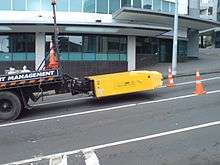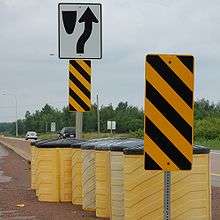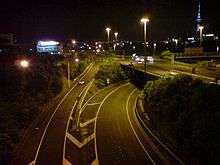Impact attenuator


An impact attenuator, also known as a crash cushion, crash attenuator, or cowboy cushion, is a device intended to reduce the damage to structures, vehicles, and motorists resulting from a motor vehicle collision. Impact attenuators are designed to absorb the colliding vehicle's kinetic energy.[1] They may also be designed to redirect the vehicle away from the hazard or away from roadway machinery and workers.[2] Impact attenuators are usually placed in front of fixed structures near highways, such as gore points, crash barrier introductions, or overpass supports. Temporary versions may be used for road construction projects.
Truck-mounted versions, similar in some ways to railcar buffers, can be deployed on vehicles that are prone to being struck from behind, such as snow plows and road construction or maintenance vehicles. Work zone regulations often specify a minimum buffer distance between the attenuator truck and the work area, and a minimum mass for the truck, to minimize the chances that the truck will be pushed forward by a crash into the workers or machinery. This is especially important in mobile work zones where the truck's parking brake may not be engaged. The truck may also be in movement (albeit slower than the vehicles that could crash into it).
Impact attenuators can be categorized by the method used to dissipate kinetic energy:
- Momentum transfer. Many early models used successive rows of sand- or water-filled barrels or modules. Momentum is transferred to the sand or water, reducing the speed of the impacting vehicle.
- Material deformation. Many newer attenuators use crushable materials that create a crumple zone, absorbing energy. Others flatten a corrugated steel guard rail section, or split a steel box beam.
- Friction. Some attenuators work by forcing a steel cable or strap through an angled slot or tube, converting kinetic energy into heat.
In the United States, impact attenuators are tested and classified according to AASHTO Manual for Assessing Safety Hardware (MASH), which superseded the Federal Highway Administration NCHRP Report 350. Classification is based on the maximum speed of a vehicle during a collision for which the attenuator is designed.
Types
Gating
Gating impact attenuators allow vehicles impacting from the side to pass through them (akin to a gate).
Gating attenuators are more economical, but require a greater clear space surrounding them to be effective; without enough space, errant cars may pass through into another hazard, such as into lanes of opposing traffic.[3][4]
Water-filled attenuators
Water-filled attenuators consist of containers filled with water to absorb impact energy. They are typically not anchored to the ground, and therefore benefit from easy deployment and relocation using barrier transfer machines and cranes. They are non-redirective, meaning they do not deflect vehicles that impact the side back into the roadway.
Fitch barriers

A Fitch barrier consists of a sand-filled plastic barrels, usually yellow colored with a black lid. The "Fitch Highway Barrier System" was invented by race car driver John Fitch after the 1955 24 Hours of Le Mans race when his co-driver, Pierre Levegh, veered out of control and into the crowd. The car burst into flames and took the lives of Pierre and 84 spectators in one of the worst accidents in racing history. He stated he was inspired by sand-filled fuel cans which he used to protect his tent from strafing during World War II.[5] Early prototypes were self funded and tested due to low initial support. As a proof of concept Fitch used liquor barrels filled with sand to create the necessary impact attenuation, then personally crash reinforced vehicles into them while recording with a high speed camera to capture the rate of deceleration.
Fitch barriers are often found in a triangular arrangement at the end of a guard rail between a highway and an exit lane (the area known as the gore), along the most probable line of impact. The barriers in front contain the least sand, with each successive barrel containing more, so that when a vehicle collides with the barrels they shatter, the kinetic energy is dissipated by scattering the sand and the vehicle decelerates smoothly instead of violently striking a solid obstruction, reducing the risk of injury to the occupants.
Fitch barriers are widely popular due to their effectiveness, low cost, and ease of setup and repair or replacement. Since first being used in the late 1960s, it is estimated that they have saved as many as 17,000 lives and approximately $400 million per year in property damages and medical expenses. [6] [7]
Non-gating
Non-gating impact attenuators arrest the motion of vehicles that impact head-on, whilst deflecting vehicles that impact the side of the barrier. They are anchored and more expensive, but can be used in tighter spaces.[3]
Crash cushions

Crash cushions are constructed of multiple segments, which crumple into each other when collided with to absorb the impact. Their main benefit is in their reusability; these attenuators can automatically return to their original position after a crash.[8]
See also
References
- ↑ http://auto.howstuffworks.com/car-driving-safety/safety-regulatory-devices/crumple-zone1.htm
- ↑ 03-21-00_.PDF
- 1 2 "Austroads Report". 2016-04-12.
- ↑ "Gating Vs Non-Gating, What's the Difference?". 2014-03-25.
- ↑ The Fitch Barrier
- ↑ Talk of the Morning: Time can't catch up with 86-year-old hot rodder.
- ↑ John Fitch, Glamorous Racer With a Flair for Danger, Dies at 95.
- ↑ "Energy Absorption . React 350 Impact Attenuator". 2016-04-12.